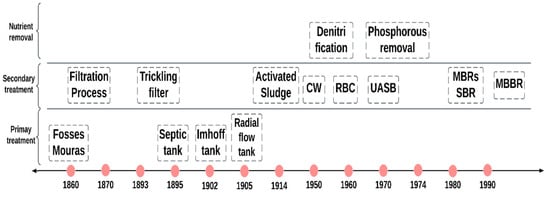Feature Papers in Membrane Bio-Reactor Valorisation (Closed)
A topical collection in Membranes (ISSN 2077-0375).
Viewed by 19103Editors
Interests: membrane bioreactor; membrane fouling; wastewater treatment; full-scale and lab-scale plant; biological treatment
Special Issues, Collections and Topics in MDPI journals
Topical Collection Information
Dear Colleagues,
The development of process-intensive technologies for wastewater treatment is a key factor to sustain population and industrial growth, while reducing their environmental impacts. Indeed, the achievement of more stringent quality standards for the discharge of treated wastewater into the environment by applying conventional technologies would require large areas and high operating costs. In recent years, membrane-based biotechnologies have been developed with the aim of increasing the treatment capacity of existing wastewater treatment plants and achieving higher-quality effluents, while reducing the plant’s footprint and energy consumption. Moreover, in light of complying with the EU policies for the transition toward a sustainable management of wastewater, the recovery of materials (nutrients, biopolymers, water) and energy should also be considered as a way toward the circular economy concept in the wastewater sector. Membrane bioreactors (MBRs) and membrane aerated biofilm reactors (MABRs) are certainly among the process-intensive technologies that are increasingly implemented for municipal and industrial wastewater treatment, enabling the achievement of higher effluent standards, the removal of emerging micropollutants and a reduced energy requirement. The main advantages of these systems include a higher effluent quality, a lower carbon footprint and lower sludge production with respect to conventional systems. However, the complexity of such biotechnologies implies both design and management issues that must be properly addressed to fully exploit their advantages and avoid adverse effects that can limit their widespread application.
Specifically, fouling minimization and resource recovery from waste streams are considered two key topics in the currently available literature. Referring to the former, membrane fouling is affected by several factors, which are related to the physiological conditions of the bacterial cells. Indeed, the physical characteristics of the bacterial cellular membranes significantly affect the sludge filtration process in an MBR system. In this case, the membrane fouling is mainly linked to the production of extracellular polymeric substances (EPSs) and to the cellular membrane hydrophobicity. Both these aspects impact the overall biological activity of the system and the filtration process, because they contribute to the formation of the “cake layer” (or “dynamic biomembrane”) that represent the system bottleneck.
Referring to the resource recovery aspects, in recent years the recovery of materials from the excess sludge has been receiving increasing interest. For example, phosphorus contained within the bacterial cytoplasm or polyhydroxyalkanoates (PHAs) represents a precious resource to recover with a view of circular economy implementation in the field of wastewater treatment. In this sense, the implementation of innovative bioprocesses applicable both in the wastewater and sludge handling units for maximizing the resource recovery is advisable to better improve the appeal of such systems.
This Special Issue aims to focus on the application of membrane-based biotechnologies to achieve the intensification of municipal and industrial wastewater treatments, including the removal of emerging micropollutants, exploiting the possibility of recovery resources (e.g., phosphorus or PHA from biological sludge), and providing insights into the process knowledge and practices aimed at overcoming the current critical management issues. In particular, research papers that analyze and improve the production and assimilation process of protein constituents (EPS content reduction) in order to decrease the membrane fouling tendency are encouraged.
We are pleased to invite you to submit original research papers, case studies and brief review articles that demonstrate the strength of membrane-based biotechnologies and exploit their potential to achieve sustainable management of wastewater.
We look forward to receiving your contributions.
Prof. Dr. Gaetano Di Bella
Dr. Santo Fabio Corsino
Collection Editors
Manuscript Submission Information
Manuscripts should be submitted online at www.mdpi.com by registering and logging in to this website. Once you are registered, click here to go to the submission form. Manuscripts can be submitted until the deadline. All submissions that pass pre-check are peer-reviewed. Accepted papers will be published continuously in the journal (as soon as accepted) and will be listed together on the collection website. Research articles, review articles as well as short communications are invited. For planned papers, a title and short abstract (about 100 words) can be sent to the Editorial Office for announcement on this website.
Submitted manuscripts should not have been published previously, nor be under consideration for publication elsewhere (except conference proceedings papers). All manuscripts are thoroughly refereed through a single-blind peer-review process. A guide for authors and other relevant information for submission of manuscripts is available on the Instructions for Authors page. Membranes is an international peer-reviewed open access monthly journal published by MDPI.
Please visit the Instructions for Authors page before submitting a manuscript. The Article Processing Charge (APC) for publication in this open access journal is 2200 CHF (Swiss Francs). Submitted papers should be well formatted and use good English. Authors may use MDPI's English editing service prior to publication or during author revisions.
Keywords
- biological membranes
- dynamic biomembranes
- membrane bioreactors
- membrane aerated biofilm reactors
- extracellular polymer substances
- fouling control
- process intensification
- removal of emerging micropollutants
- material and energy recovery









